Where Life is Better
Solo exhibition: Interactive, inter-media installation
I space
Chicago Gallery of the
University of Illinois at Urbana-Champaign
230 W. Superior, Chicago, IL, USA
September 05 to October 06, 2003
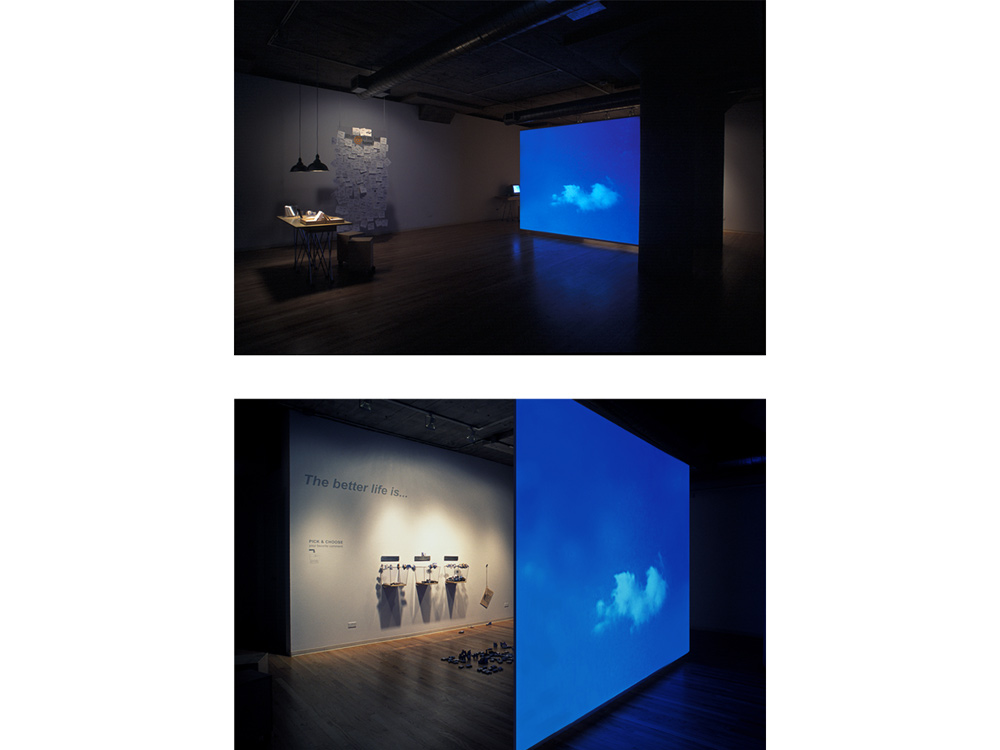
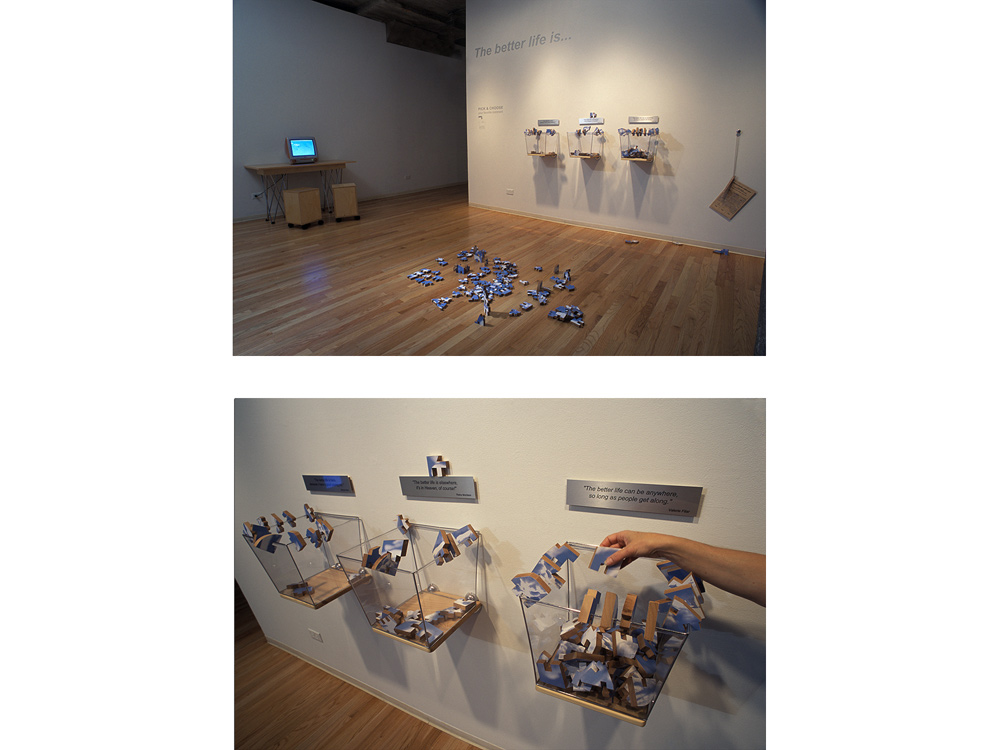
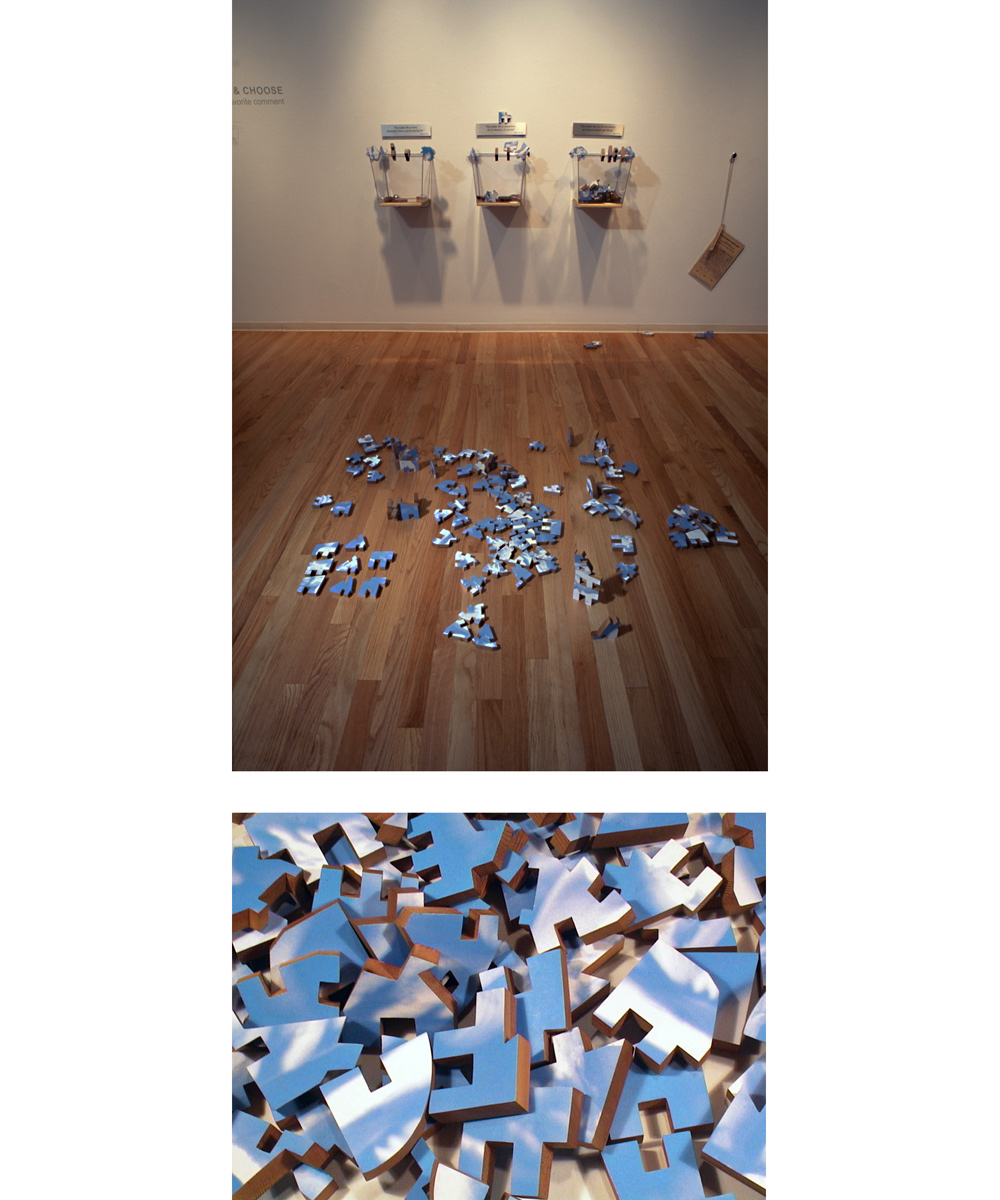
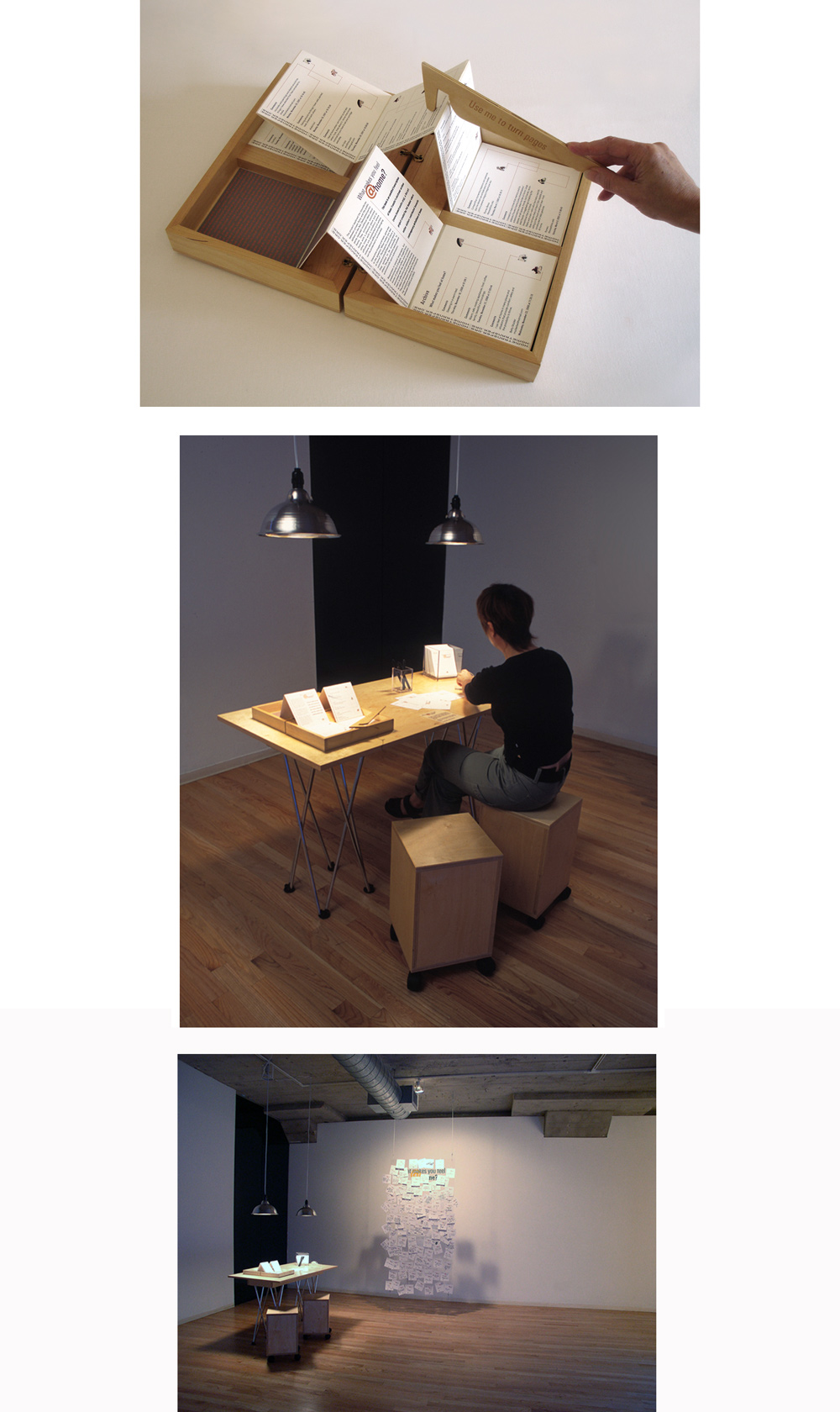
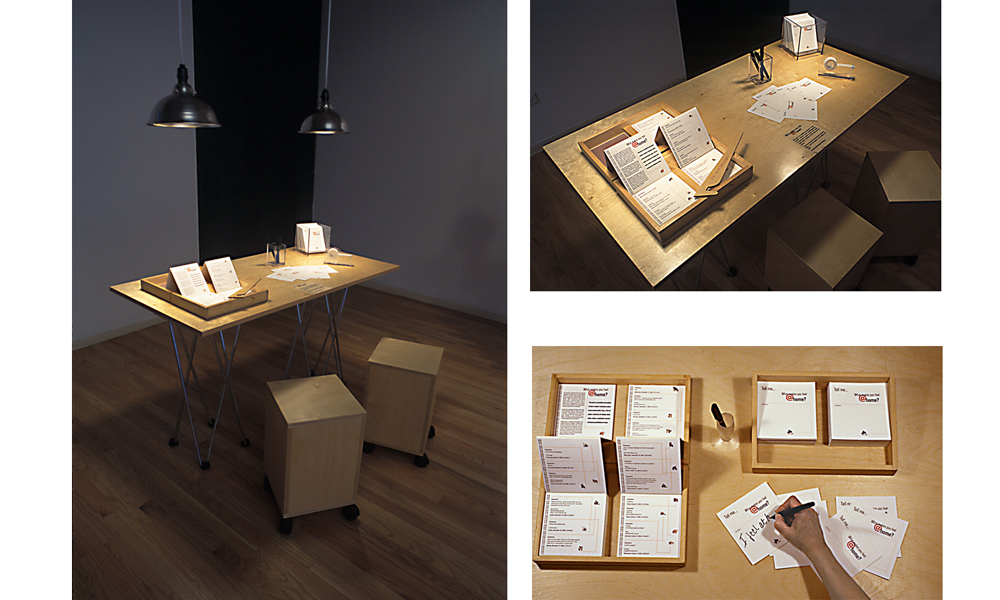
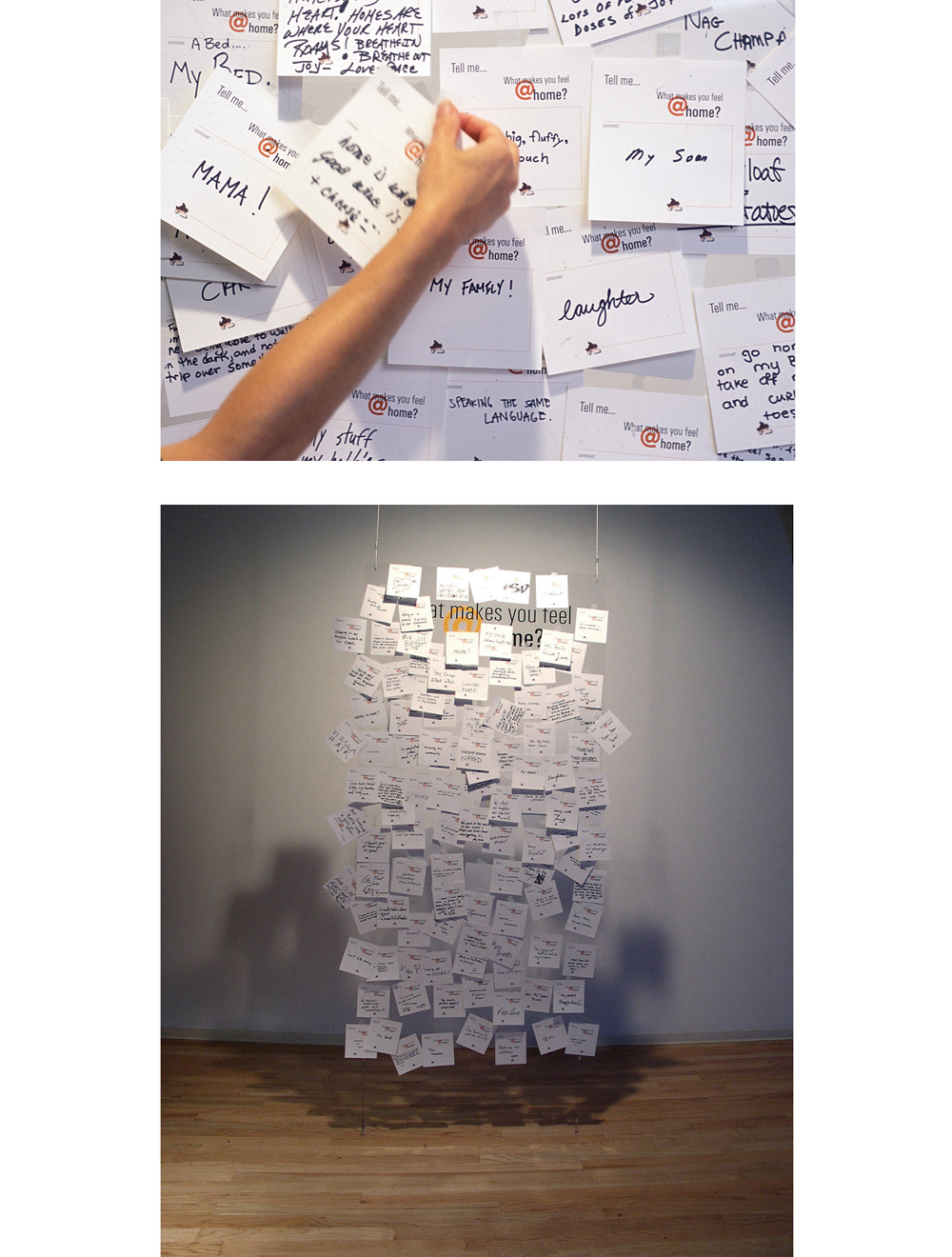
Introductory notes by Valerie Lamontagne and Pat Badani
Thread 1: Valérie Lamontagne
"The Wizard of Oz" concludes with Dorothy clicking her ruby slippers and intoning: "There's no place like home", which transports her back to the comforting, predictable environment that is 'home'. Filmed in late 1930's America, the film reflects notions of displacement and Otherness that were being questioned through the transforming effects of mass-emigrations, world travel, and early technology. Today, distance and difference have become so blurred through the aegis of hyper-technology and global processes, that the fixed identity of home - of being in and of a place - has shifted to the point of collapse. Samuel Weber notes that, "Ever since Aristotle's Physics, 'place' has been defined in terms of immanence, stability and containment, as 'the innermost motionless boundary of what contains'. In the goings-on of modern technics, by contrast, this 'innermost boundary' is forced, driven out of its motionless state. It begins to move. To be sure, this was already true in ancient technics, which was a way of unsecuring, of unsheltering, of displacing. In its modern version, however, the principle of containment no longer serves as a self-evident prerequisite of order. Instead, place as container breaks up and in so doing discloses the problematic consequences of an ordering that can no longer be taken for granted." This unraveling of the boundaries of 'place' is at the heart of Dorothy's adventure in Oz. The possibility of a better life, always located elsewhere - somewhere over the rainbow - is endemic of modern living where no place is contained and no home fixed. In displacement, now a commonality of a global society, we collectively share a shifting definition of placement, heritage and belonging. This new 'home', located in a fluid zone extending cultures, geography and history, is at once liberating and a cause for anxiety. Homi K. Bhabha reminds us that: "It is in the emergence of the interstices - the overlap and displacements of domains of difference - that the intersubjective and collective experiences of nationness, community interest, or cultural value are negotiated." These cultural interstices permit us to dream of a better place and to embrace the Otherness within and around ourselves as we redefine the essence of 'home'.In her current exhibition at Ispace, Where Life is Better, Pat Badani invites us to question "Where is life better?". Badani's oeuvre has long explored notions of place and belonging. A citizen of the world herself, her work is acutely involved in the process of setting these questions at play within multimedia installations that invite the public-at-large to experience and participate in her knowledge-building form of art. In the exhibition Where life is better, we discover mutable texts and audio/video archives rich with first-person reflections. Comments on the notion of home made by over 300 individuals, culled through her Hometransfer.org website, are transcribed into an interactive book that invites visitors to further add personal observations on a graffiti wall of notes. We are also called upon to 'play' with dwelling-shaped objects, transforming a series of wall-mounted sentences on the topic of a better life, into a personalized and democratic narrative. Finally, a multimedia installation work features candid testimonies culled from a series of interviews filmed during the artist's research into her upcoming project: Where are you from? In her present exhibition, Badani offers us the opportunity to experience globally shifting notions of 'place', 'home' and Otherness in a transnational meditation on the question of what a "better life" means today.
Thread 2: Pat Badani
Where Life is Better is the latest of 8 projects exploring material and immaterial environments in which we live: the home, the city, and virtual territories. These projects, produced since 1994, deal with the anxiety of no place from various perspectives: lost place, the place regained, the projected ideal place (or merely better) and the search for it through displacement. The multimedia installation at Ispace results from a recent experience. In 2002-03, I set off to trace my personal geography through 6 cities: Buenos Aires, Mexico City, Montreal, Toronto, Paris and Chicago. I videotaped conversations about a "better-life" with average individuals in each of these hybrid cities. The works at Ispace include a selection of voices from the people I encountered in this journey. These voices are juxtaposed to written testimonies on "feeling at home" that I have collected since 2000 from global passersby on the www.My works are a laboratory for me to filter personal experience, and build knowledge and understanding. Because I think communication is essential to knowledge, some of these projects also create discrete communicational spaces that allow citizens-at-large to become actively involved in the knowledge-building process through their participation. Bakers, medical doctors, architects, the average passer-by in city spaces and on the www, have become part of a collaborative process in which the meaning of the work is expanded through their gestures, texts and dialogue.The exhibition Where Life is Better at I space, likewise creates a discrete communicational space by means of several interrelated elements that explore notions about a better way of life. Visitors to the gallery interact with the works and participate in the production of meaning by expressing choices and opinions.
Where Life is Better Valérie Lamontagne interviews Pat Badani
VL: Where Life is Better involves cultural research, participatory installation and documentary-based archives, which are situated at the juncture of material and digital environments. Could you further explain why you choose to combine these elements both in your process and presentation?
PB: My work is at the juncture of a number of practices. My choices are made during a process of discovery and analysis, and are contingent upon the language that best embodies the requirements of each project. As for research: my work is experiential, a way to understand where I am (we are) in the present and explore some possibilities for the future. This has led me to readings in several disciplines including media and new media. I also sometimes form collaborations with individuals in the social sciences to research issues related to space, place, cities, communication, global processes and digital environments.Documentary and installation as work process and presentation have been part of my work for a while. In the mid 90's I explored photographic travelogues and included these productions within installations. Towards the end of the 90's, I started to favour performative projects as an extension to previous explorations. The new projects functioned as a forum for dialogue where photography and video became a way to document the time-based situations. At this time, I also began investigating the www as a way to include global, delocalised participants in projects that involved the public sphere and participation. In Where Life is Better at "Ispace", there are 2 object-based installations that invite participation, a video projection and a Web-work (www.hometransfer.org/betterlife.html) with audio documents I have collected since 2002. The gallery visitor reconstructs these multiple channels of information that unfold in time and interrelate in space. I am interested in the potential for engagement with others offered by these diversified practices and presentation strategies.
VL: The home is a reoccurring theme in your work. Gaston Bachelard notes how "He [the individual] experiences the house in its reality and in its virtuality, by means of thoughts and dreams." Where Life is Better addresses the notion of telematic "belonging" wherein home is also both a construct and a reality. Is home a "what" or a "where" or both?
PB: The word home often brings up images of a physical structure like a house, but the word's accepted meaning usually refers to the social and psychological shelter created in the domestic environment, the affective and relational support that one might receive there, including family. Home can also refer to location, such as the homeland and its associated concept of nationhood. For many of us today, ideas of home have become an unstable, anxiety ridden territory. This may be due to the perpetual changing nature of contemporary living conditions, with relocation and mass migration contributing to a sense of no place. Those who are displaced often need to count upon some reliable place, one that may oscillate between the past -a place to go back to, and the future -a place to go towards, like a better place. But home can also refer to a state of being, a condition of connectedness where notions about selfhood and belonging can be re-created, a state where one is in place and @ home. This space in the mind is a virtual one, a notion that might re-orient definitions of "what" or "where" attached to definitions of home. "Telematics" , computer mediated communication like the Internet, provides instantaneous links between geographically dispersed individuals. Because it transcends the body's placement in a physical structure or location, "telematics" has opened new horizons in the process of negotiating relationships between people and places, offering alternative structures for the creation of knowledge and of being at a distance, potentially enhancing the condition I mention above. But, the question of "telematic belonging" which had a seductive utopian note when cyberspace was presented as a pure no place where human interaction could occur in a democratic and cerebral way is now relativized.
VL: William J. Mitchell notes how the "worldwide computer network - the electronic agora - subverts, displaces, and radically redefines our notions of gathering, place, community, and urban life." Are you, with the projects Where Life is Better and Where Are You From?, aiming to bridge the gap between networked and non-networked communities who do not have access to self-expression on the www? And if so, what are your strategies for diversified community participation?
PB: With these projects my focus is to explore notions of belonging articulated through mobility as well as the relationship between global processes and local environments, more so than networked and non-networked communities. As for general strategies: a number of my projects happen outside the studio and in non-cultural/art-venues. These projects are interventions that establish a spatial and temporal order in public space in carefully chosen urban settings and, more recently, on the www, which I use as an extension of the urban. I organise activities that incorporate direct lived experience to reveal a certain morphology of everyday life through encounter and dialogue. These works are participatory, in that part of the production results from people's active involvement in the project. My aim is to establish contact and exchange with ordinary individuals, representing diverse constituencies (economic, cultural, linguistic). With regards to interviewing the public in city spaces; I develop a number of specific strategies in order to engage a diversified community. These strategies include international travel; communication in several languages; the skill to relate to different cultural codes in combination to the ability to strike conversations with strangers; familiarity with urban spaces in several countries and their use by the public; trandisciplinary research and team work. Regarding strategies to engage participation on the www; I set up simple systems in Web-works that include: interactivity through dynamic graphics, streaming audio and video, and participation through available Web-based communication technology. The www is an inclusive platform, a vehicle for production, distribution and participation in which I can also access broadcast time in a way that I cannot through other systems (i.e. television). In addition, reaching a diversified global community is potentially greater on the www. With works like Where are you from? (currently in its pre-production stage) I aim to explore everyday encounters in more than one local space. My intention is to engage the public sphere simultaneously on the www and in city spaces, integrating the displacement favoured by global networks.
VL: Where Life is Better, is a parallel project to Where Are You From? which aims to map cyber/analog space as well as private / public space. And yet, it could be argued that the virtual/analog space dichotomy has become increasingly blurred. "As such, interactions within cyberspace, whether it involves altering records, conducting business or monitoring the city, have consequences on people in real space." Do you believe that technology affords greater agency to impact changes within real space? And if so, what becomes of real space?
PB: My work has explored spatial mapping for a decade in city spaces, natural spaces, workspaces, and living spaces. Since 1999 I have also been interested in mapping social space in electronic environments, specifically on the www. I see one space as a continuum of the other, differentiated yet complementary. I am interested in developing processes that bridge virtual/analog as well as private/public spaces, and blur boundaries between a number of habitually distinct categories.I believe that technology has always offered humanity new possibilities and greater agency. This is also true in cyberspace. Seen as a computer mediated space that extends social interaction, it structures daily living with a constant flow of information and exchange. The re-structuring of "real" space, or physical space (which is in constant flux due to numerous forces), have included a re-evaluation of notions of place and presence. Anthropologist Arjun Appadurai argues that electronic mediation offers "new resources and disciplines for the construction of imagined selves and worlds".
VL: "As a recording witness of events and fictions, video has become our individual and collective memory." Video and audio documents stand in for the voices of the people you interview in Where Life is Better and is an integral source in the development of the work. In regards to video as a repository for "memories" how do you perceive your role of author/filter/editor/facilitator for these recorded public discussions? What are your goals when interviewing the public and how do you reconcile your precarious role as a post-modern "author"?
PB: My role when collecting video and audio documents from everyday individuals, who follow no script but rather respond to my prompting, is to favor communication within a topic of discussion framed by a system I have developed ahead of time. My approach is informed by recording considerations in documentary film and journalism, and by culture-centered interviewing techniques used by counselors, which I integrate to performative situations that place the participant at the center of the stage. The value of interviewing the public resides in that I can present multifocal viewpoints to a subject, and deflect a single or Manichaean perspective. With the upcoming Live Webcast project Where are you from? my role as facilitator during the course of interviewing the public is emphasized over my role of author/editor, because the captured reality will be broadcast live. This approach questions who is actually producing and controlling the meaning of the work (me, the participant, the audience?) and accentuates my tenuous position as "author". Editing has the virtue of selectivity, and I rely on it to process and present very specific material that I have archived, as in the case of video-clips in my web-work http://www.hometransfer.org/where/stories.html, as well as with the audio documents presented in this exhibition. With this approach, I sort out what I think is the most meaningful information, based on critical analysis and cultural understanding. When I integrate this material from the everyday into the texture of an art-piece that is not about purely documenting reality, a certain degree of subjectivity and artifice inevitably comes into play; considerations which I need to negotiate as author.
VL: "Otherness" has become an ever-present axiom through which we can define the ebb and flow of cultures, identity and place. Julia Kristeva notes how "The strange happiness of the foreigner consists in maintaining that fleeing eternity or that perpetual transience." The notion of perpetual "otherness" in Where Life is Better seems a fitting investigation. Does this reflect some of the autobiographical aspects of your work, for example, your nomadism and trans-cultural identity?
PB: Kristeva's book "Strangers to Ourselves", reveals pertinent questions/answers about my own wandering biography marked by repeated self-exile. Driven perhaps by the desire to escape the notion of origin and by curiosity about a promised land elsewhere, I have felt at home in that in between space that Kristeva labels "perpetual transience". My projects reflect the various stages of enacting a nomadic process inhabiting this liminal space. Where life is better certainly reflects these concerns, and incorporates autobiographical identity markers (like the house-like shapes that derive from fragments of a puzzle from France, where I lived in the 90's; or the location of the projected sky that I filmed two months ago in Buenos Aires, the city where I was born; or the narrative elements included in the multimedia audio, captured recently in Montreal). These sometimes-cryptic personal markers are part of the work's topology. But the work transcends the personal scope, by incorporating and interweaving the voices of multiple Others. The sum of the two creates a far greater and more generative texture.
Bibliography
-Samuel Weber, "Mass Mediauras: form technics media". Stanford University Press: Stanford, California,1996. p.70.
-Homi K. Bhabha, "The Location of Culture". Routledge: London and New York, 1994. p.2.
-Gaston Bachelard. "The Poetics of Space". Translated from the French by Maria Jolas. Beacon Press: Boston,1964. p.5.
-"Telematics"- A term coined in 1978 by Simon Nora and Alain Minc.
-Edward A. Shanken, "Tele-Agency: Telematics, Telerobotics, and the Art of Meaning". Art Journal 59:2 (Sum 2000): 64-77.
-Lisa Nakamura, "Cybertypes - Race, Ethnicity, and Identity on the Internet". Routledge: NY & London, 2002. P. 87.
-William J. Mitchell, "City of Bits: Space, Place, and the Infobahn". MIT Press: Massachusetts, 1996. p.8.
-Martin Dodge and Rob Kitchin, "Mapping Cyberspace". Routledge: London, 2001. p.189.
-Arjun Appadurai, "Modernity at Large: Cultural Dimensions of Globalization". University of Minnesota Press. Minneapolis, 1996. p.3.
-Louise Poissant, "Video: Writing History" in Peggy Gale and Lisa Steele, Editors. Video re/View. Art Metropole and V Tape: Toronto, 1996. p.190.
-Julia Kristeva, "Strangers to Ourselves". Columbia University Press: New York, 1994. p.4.
Bio :
Valérie Lamontagne is an artist, freelance art critic and curator based in Montréal, Canada. She regularly writes about new media and performance art in international publications, and is co-founder of MobileGaze.com, a net.art site featuring art and interviews with artists and digital media producers.